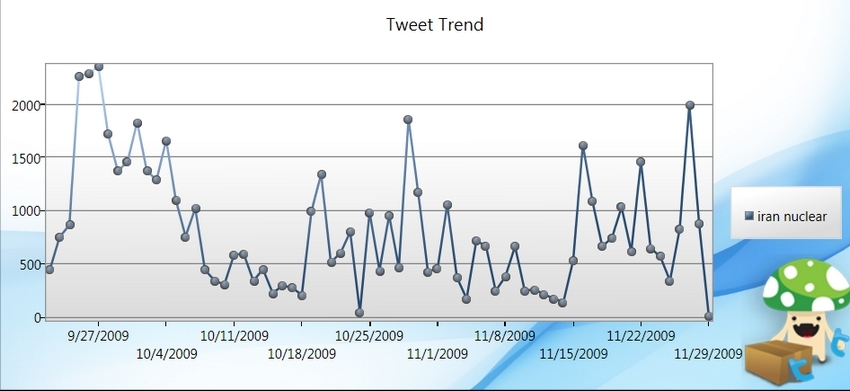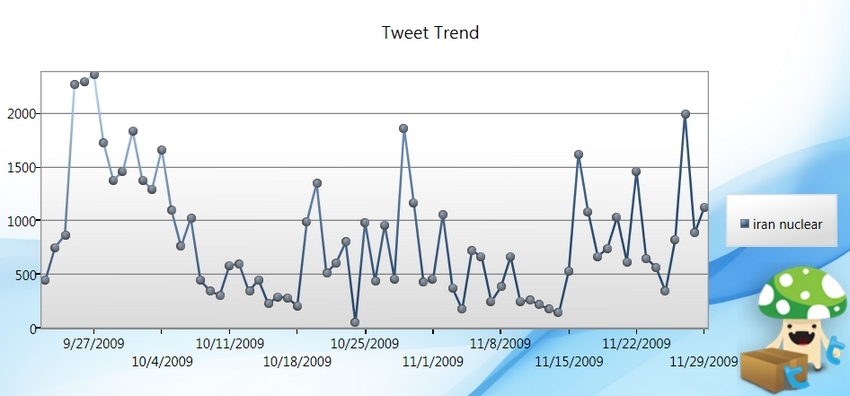
The difference an announcement can make
G. R. Boynton
The general puzzle is: can we expect discernable patterns in day to day messaging on Twitter and other microblogging systems? Can we interpret the changing messaging as changing focus of attention as the events in 'the world' change? This note is about one such case.
Iran and western governments have been playing tag over Iran developing nuclear production facilities for more than a decade. Iran says, we are doing this for peaceful purposes. Our hospitals need it for treating certain illnesses. We need it to guarantee our energy independence. ETC. The western governments say we know better. We know you would develop it for weapons. So we are going to make this 'bargain.' We will sell you the nuclear materials you need and you do not develop the facilities to produce.
Apparently, the western governments think Iran should be grateful to accept second class citizenship in a world in which everybody who is anybody has nuclear production facilities. Iran has never agreed to the western bargain. But the bargaining goes on and on. Until today, November 29, 2009.
I started following the messaging about Iran and nuclear production on September 23, 2009. President Ahmadinejad spoke to the General Assembly of the United Nations. The Washington Post reported.
Iran is willing to have its nuclear experts meet with scientists from the United States and other world powers as a confidence-building measure aimed at resolving concerns about Tehran's nuclear program, Iranian President Mahmoud Ahmadinejad said Wednesday.
That seemed promising to western leaders, but only two days later it was revealed that Iran had secretly constructed a second nuclear production facility the IAEA had not known about. That was a big enough deal that it became 'breaking news' for The Post.
 |
The figure gives the number of twitter messages per day beginning September 23, 2009 and running through November 29. The UN announcement by Ahmadinejad precipitated 741 messages on the 23th and 851 on the 24th. The announcement that Iran had secretly constructed a second nuclear production facility -- breaking news for The Post -- led to considerably more messaging. On the 25th it was 2257 messages, 2284 on the 26th and 2346 the next day.
The Post issued a second breaking news about Iran on the first of October. Iran again agreed to negotiations and IAEA inspection of the second facility. The announcement generated 1818 messages, which is clearly visible at the middle of the figure.
The figure distributes 55,076 messages across the time period September 23 through November 29. The average number of messages per day is 810, but there is clearly great variety in messaging from day to day.
Without attempting to trace events and all the ups and downs of messaging there is one more example of event and messages. The last day in the above figure is November 29. The count for the day as of 1:45 p.m. Central was 2 and that is indistinguishable from 0 on the figure. The figure below is for November 29 at 9:21 p.m. Central.
 |
Instead of 0 for the 29th there are now 1116 messages for the day. What happened? Iran announced that they had had it with negotiations and they would build 10 nuclear production facilities. This is The Post's breaking news announcement.
11:12 AM EST Saturday, November 29, 2009
State-run media says Tehran has approved a plan Sunday to build 10 industrial scale uranium enrichment facilities, a dramatic expansion of the program in defiance of U.N. demands it halt enrichment efforts.
From 2 to 1116 reacting to one announcement looks a lot like a discernable pattern. It seems particularly convincing since we know all of the messaging occurred after the announcement.
What to conclude?
One case does not a general pattern make. But it seems pretty clear that in this case attention waxes and wanes with the moves of political leaders -- however counterproductive they may be. This is undoubtedly our expectation.
But what can we make of moves of political leaders that are ignored? when no one is paying attention? It is entirely possible to find instances of that, as well. That is another puzzle for another note.
![]() G. R. Boynton
G. R. Boynton
November 29, 2009
For more streams of messages see: There's a hashtag for that.